I’ve got a small project I’m building, and I’m stuck on a semi-circle for my plans. I’m not bad at math, but I’m rather rusty. I have to make a curved cut, and I’ve got three points it needs to go through, and I want to make it a smooth curve throughout. If this was on graph paper, the points would be (0,21);(13.5,13.5);(22,0). I’ve tried looking online, but I’m just confused, and I end up scratching my head for a long time. Short of hiring a math professor, is there any easy way to do this? I just want to figure out what the radius of the circle should be, and I can sort out where the center point is. Thanks in advance.
Discussion Forum
Discussion Forum
Up Next
Video Shorts
Featured Story

There are some instances where multiple minisplits make sense.
Featured Video
Video: Build a Fireplace, Brick by BrickHighlights
"I have learned so much thanks to the searchable articles on the FHB website. I can confidently say that I expect to be a life-long subscriber." - M.K.
Fine Homebuilding Magazine
- Home Group
- Antique Trader
- Arts & Crafts Homes
- Bank Note Reporter
- Cabin Life
- Cuisine at Home
- Fine Gardening
- Fine Woodworking
- Green Building Advisor
- Garden Gate
- Horticulture
- Keep Craft Alive
- Log Home Living
- Military Trader/Vehicles
- Numismatic News
- Numismaster
- Old Cars Weekly
- Old House Journal
- Period Homes
- Popular Woodworking
- Script
- ShopNotes
- Sports Collectors Digest
- Threads
- Timber Home Living
- Traditional Building
- Woodsmith
- World Coin News
- Writer's Digest



















Replies
A circle is the set of all points in a plane whose distances from a fixed point (in the plane) are equal. The fixed point is called the center. The distance from the center to one of the points is called the radius. Any of these points, other than the center, is said to lie on the circle.
Center (h,k) and radius = r
If a center of the circle is at the origin (0,0) and its radius is r, with P(x,y) representing any point on the circle, then its equation is x^2 + y^2 = r^2
If the center of the circle is at the point (h,k) and its radius is r, with P (x,y) representing any point on the circle, then its equation is (x-h)^2 + (y-k)^2 = r^2
Not a math whiz myself, but based on your "graph paper" points it sounds like you are describing a 90 degree arc rather than a semi-circle.
Being somewhat math challenged I have devised certain coping behaviors to solve problems such as yours.
In your case I would draw the problem, full sized or scaled to something manageable, the bigger the better.
1) Accurately plot the three known points which you need to hit.
2) Set a beam compass or a pair of trammel points to a rough radius, sounds like it is about 21.5 "units" (inches, feet, cubits or whatever).
3) Scribe an arc in the vicinity of your center from all three known points.
4) Adjust the length of the radius on the beam compass or trammels until all three arcs hit a single point. This will probably take several tries.
5) The resulting single point is the center and the length on the beam compass/trammels is the needed radius. Results are easily confirmed by swinging your radius from your "found" center and checking for a hit on all three of your start points.
I know it is not very scientific, but it works on any circle or part thereof.
Good luck!
Jim
Never underestimate the value of a sharp pencil or good light.
I finally figured it out... I finally found a calculator online that does it automagically. I can enter in the x,y coordinates for each of the three points I want the circle to point to, and it determines the radius of the circle, and the center point of the circle.Located here: http://home.att.net/~srschmitt/script_circle_solver.htmlI can now figure out exactly how make my circle come out nearly perfect when I cut. Thanks for your time
nater: I'm running out of time and have to log off soon, and it's water under the bridge anyway since you have a solution. But here's as far as I got with your question (hopefully correct! I did this in a hurry):
I took the points to be the vertices of a triangle and solved for the three sides using the formula Square Root[(x1- x2)² + (y1- y2)²] obtaining lengths of 30.41381, 15.44345 and 15.95306. Then I solved for the radius of the circumcircle that passes through the vertices and got a radius of 31.616102. Judging by your points your circle is "off center"; I haven't figured out how much at this time.
If you're happy with a graphical solution you can also solve for the center geometrically by connecting pairs of points and finding the perpendicular bisectors of the lines. The bisectors intercept at the center of the circle.
I'll make a note of your points, play around with this problem later tonight and post what I think is the correct answer tomorrow.
Joe Bartok
Edited 9/13/2005 5:24 pm ET by JoeBartok
Edited 9/13/2005 5:25 pm ET by JoeBartok
Hi Nater;
Start in your corner .785 x D squared
Edited 9/14/2005 6:49 pm ET by Renovator
A tall stick and the sun works too..make a sundial.
Spheramid Enterprises Architectural Woodworks
Let's see if I got lucky. I plotted it in AutoiCad using inches for the coordinates you gave. That resulted in a radius of 2'-7 5/8" with a center point at -8 1/8", -9 9/16".
"When asked if you can do something, tell'em "Why certainly I can", then get busy and find a way to do it." T. Roosevelt
FastEddie: I think you got lucky and I like those numbers.
nater: I pursued the math last night and while I was at it made up this Circle Calculator. If you enter the points you gave you'll get the radius I calced yesterday and FastEddie's points for the center. This calculator finds the chords which form a triangle and then determines the intercept of the perpendicular bisectors trigonometrically.
But there's another way of determining the radius without the trig: Solving the Equations. I only had a few minutes last night and didn't have time to post the information. This process emplys the same circle formula bbgjason posted:
(x - h)² + (y - k)² = r²
Hope this helps.
Joe Bartok
Edited 9/14/2005 10:35 am ET by JoeBartok
thanks for the math links.
sometimes a perfect circle won't work and you need to ooch it into an oval. here's a cool homemade "trammel point" device to scribe an oval:
partially sink 2 nails into a surface, for eg, 12 inches apart. tie a circle of twine that, when looped over one nail (your center), reaches past the second nail. how much depends on the size and proportion you want your oval. for eg, 3" past the second nail. make sure both nails are inside the loop and pull taut with a penci. now draw your line keeping the loop taut until you've gone all around. oval! there may be a mth formula to figure your points, but with a little trial and error in the length of the loop and distance between the nails, it's easy to get what you want.
There is a formula for the foci of an Ellipse - but we don't really need it. You can set your compass or trammels to the length of the semi-major axis, place one point where the pencil is shown in the drawing and scribe marks on the major axis. Those are the foci or the points where we place the nails.Joe Bartok